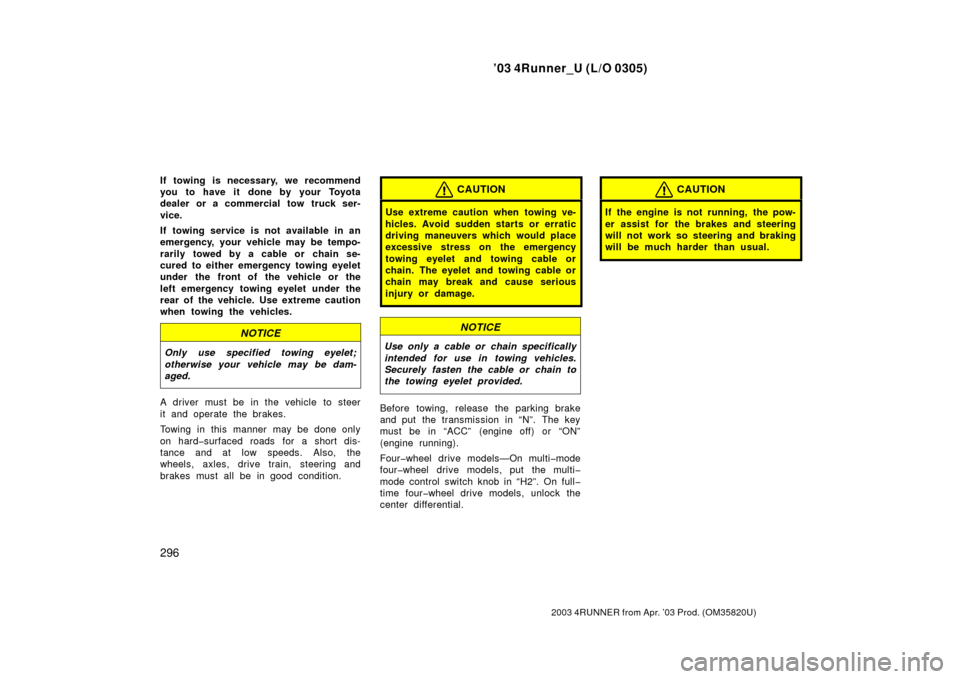Page 302 of 373

’03 4Runner_U (L/O 0305)
296
2003 4RUNNER from Apr. ’03 Prod. (OM 35820U)
If towing is necessary, we recommend
you to have it done by your Toyota
dealer or a commercial tow truck ser-
vice.
If towing service is not available in an
emergency, your vehicle may be tempo-
rarily towed by a cable or chain se-
cured to either emergency towing eyelet
under the front of the vehicle or the
left emergency towing eyelet under the
rear of the vehicle. Use extreme caution
when towing the vehicles.
NOTICE
Only use specified towing eyelet;
otherwise your vehicle may be dam-
aged.
A driver must be in the vehicle to steer
it and operate the brakes.
Towing in this manner may be done only
on hard�surfaced roads for a short dis-
tance and at low speeds. Also, the
wheels, axles, drive train, steering and
brakes must all be in good condition.
CAUTION
Use extreme caution when towing ve-
hicles. Avoid sudden starts or erratic
driving maneuvers which would place
excessive stress on the emergency
towing eyelet and towing cable or
chain. The eyelet and towing cable or
chain may break and cause serious
injury or damage.
NOTICE
Use only a cable or chain specifically
intended for use in towing vehicles.
Securely fasten the cable or chain to
the towing eyelet provided.
Before towing, release the parking brake
and put the transmission in “N”. The key
must be in “ACC” (engine off) or “ON”
(engine running).
Four�wheel drive models—On multi�mode
four�wheel drive models, put the multi�
mode control switch knob in “H2”. On full�
time four�wheel drive models, unlock the
center differential.
CAUTION
If the engine is not running, the pow-
er assist for the brakes and steering
will not work so steering and braking
will be much harder than usual.
Page 318 of 373

’03 4Runner_U (L/O 0305)
312
2003 4RUNNER from Apr. ’03 Prod. (OM 35820U)
INSIDE THE VEHICLE
Items listed below should be checked
regularly, e.g. while performing periodic
services, cleaning the vehicle, etc.
Lights
Make sure the headlights, stop lights, tail
lights, turn signal lights, and other lights
are all working. Check headlight aim.
Service reminder indicators and warning
buzzers
Check that all service reminder indicators
and warning buzzers function properly.
Steering wheel
Check that it has the specified free play.
Be alert for changes in steering condition,
such as hard steering or strange noise.
Seats
Check that all front seat controls such as
seat adjusters, seatback recliner, etc. op-
erate smoothly and that all latches lock
securely in any position. Check that the
head restraint move up and down smooth-
ly and that the locks hold securely in any
latched position. For folding�down rear
seatbacks and swing�up rear seat cush-
ions, check that the latches lock securely. Seat belts
Check that the seat belt system such as
buckles, retractors and anchors operate
properly and smoothly. Make sure that the
belt webbing is not cut, frayed, worn or
damaged.
Accelerator pedal
Check the pedal for smooth operation and
uneven pedal effort or catching.
Brake pedal
Check the pedal for smooth operation and
that the pedal has the proper clearance.
Check the brake booster function.
Brakes
At a safe place, check that the brakes do
not pull to one side when applied.
Parking brake
Check that the pedal has the proper travel
and that, on a safe incline, your vehicle
is held securely with only the parking
brake applied.
Automatic transmission “Park” mecha-
nism
On a safe incline, check that your vehicle
is held securely with the selector lever in
“P” position and all brakes released.IN THE ENGINE COMPARTMENT
Items listed below should be checked
from time to time, e.g. each time when
refueling.
Washer fluid
Make sure there is sufficient fluid in the
tank. See page 343 in Section 7�3 for
additional information.
Engine coolant level
Make sure the coolant level is between
the “F” and “L” lines on the see�through
reservoir when the engine is cold. See
page 326 in Section 7�2 for additional
information.
Radiator, condenser and hoses
Check that the front of the radiator and
condenser are clean and not blocked with
leaves, dirt, or insects. See page 328 in
Section 7�2 for additional information.
Page 361 of 373
’03 4Runner_U (L/O 0305)
355
2003 4RUNNER from Apr. ’03 Prod. (OM 35820U)
DIFFERENTIAL (2UZ�FE engine)
Oil capacity, L (qt., Imp. qt.):
Two�wheel drive models 3.05 (3.2, 2.7)
Four�wheel drive models Front 1.4 (1.5, 1.2)
Rear 3.05 (3.2, 2.7)
Oil type: Hypoid gear oil API GL�5
Recommended oil viscosity:
Above �18 �C (0 �F)
SAE 90
Below �18 �C (0 �F)
SAE 80W or 80W�90
CHASSIS LUBRICATION
Propeller shafts: Spiders and slide yokesLithium base chassis grease, NLGI
No.2 BRAKES
Minimum pedal clearance when depressed
with the force of 490 N (50 kgf, 110 lbf)
with the engine running, mm (in.):
55 (2.2)
Pedal free play, mm (in.): 1—6 (0.04—0.24)
Pad wear limit, mm (in.): 1.0 (0.04)
Lining wear limit, mm (in.): 1.0 (0.04)
Parking brake adjustment when depressed
with the force of 294 N (30 kgf, 66.1 lbf): 5—7 clicks
Fluid type: SAE J1703 or FMVSS No.116 DOT 3
STEERING
Wheel free play: Less than 30 mm (1.2 in.)
Power steering fluid type: Automatic transmission fluid DEXRON �II
or III
Page:
< prev 1-8 9-16 17-24